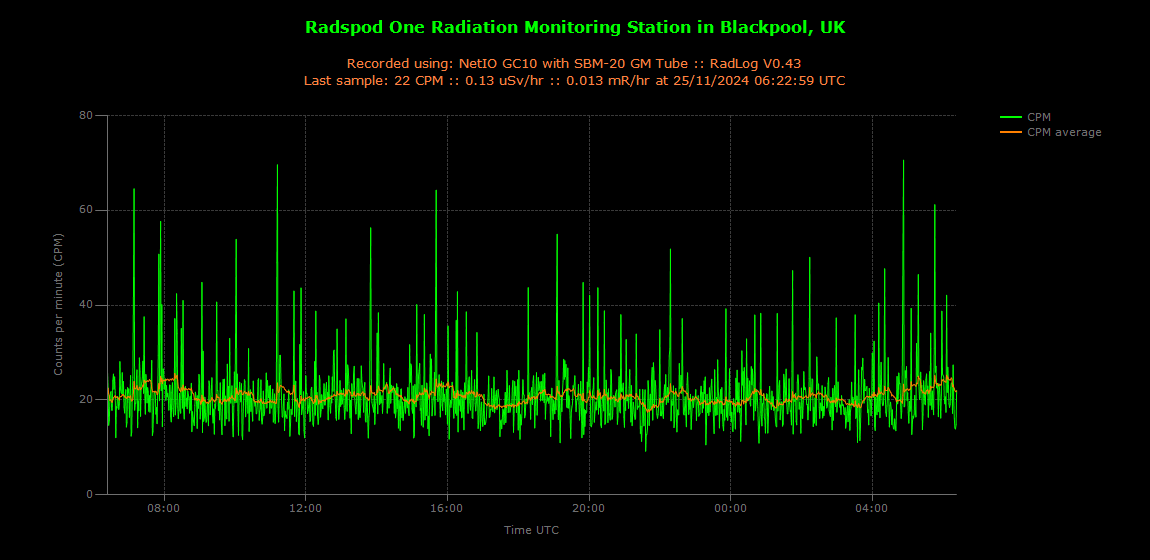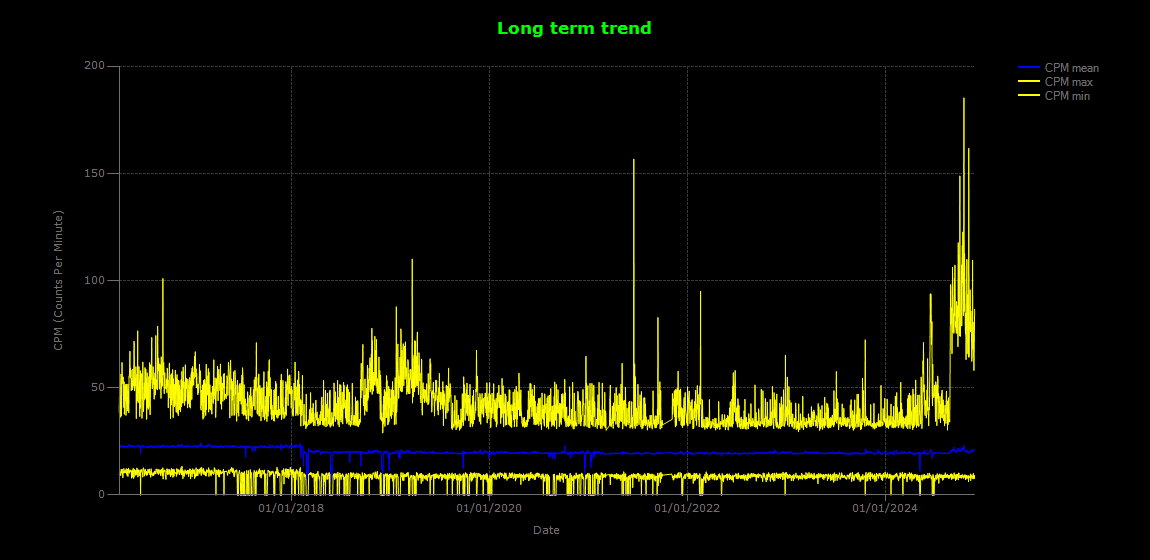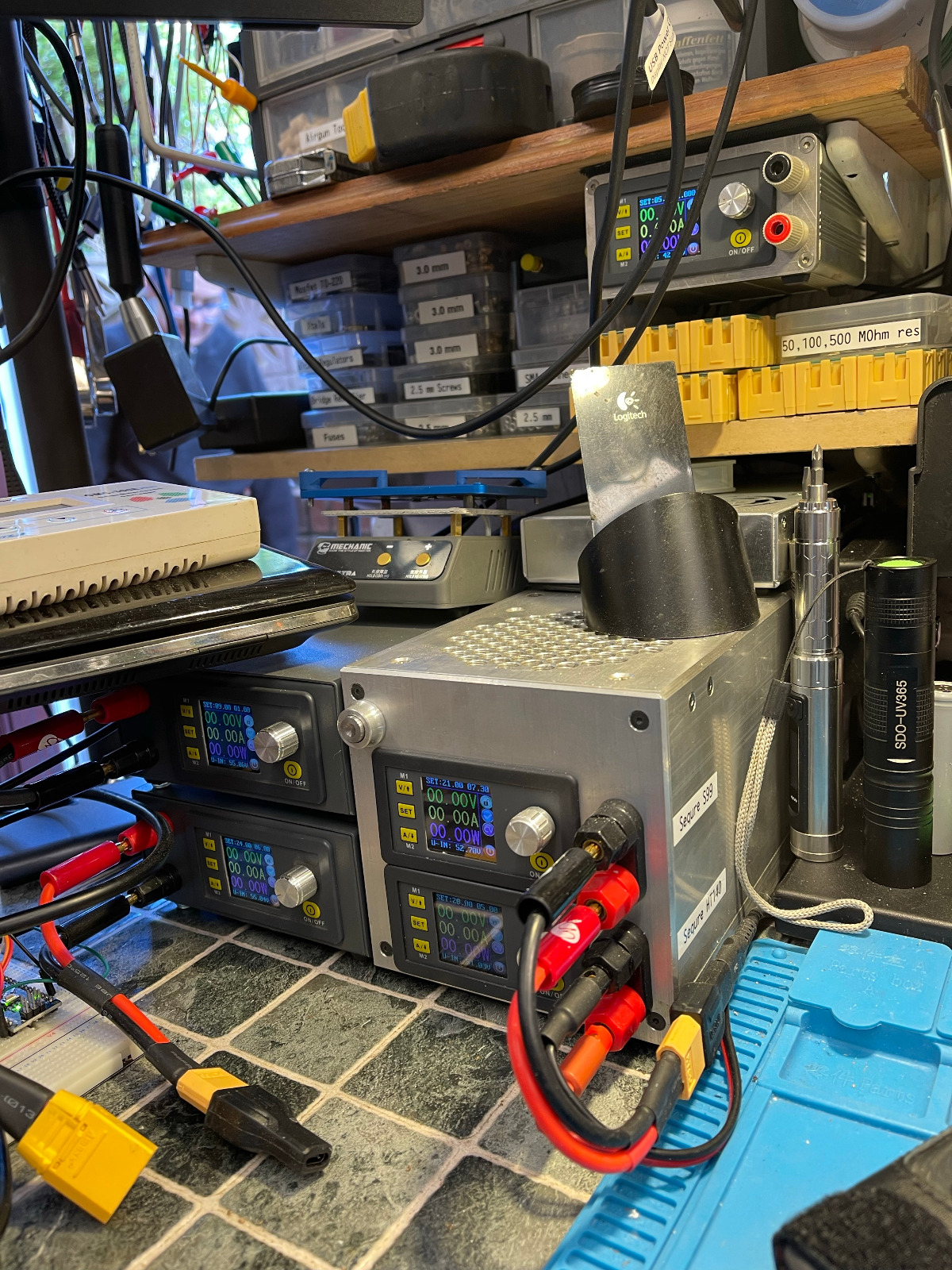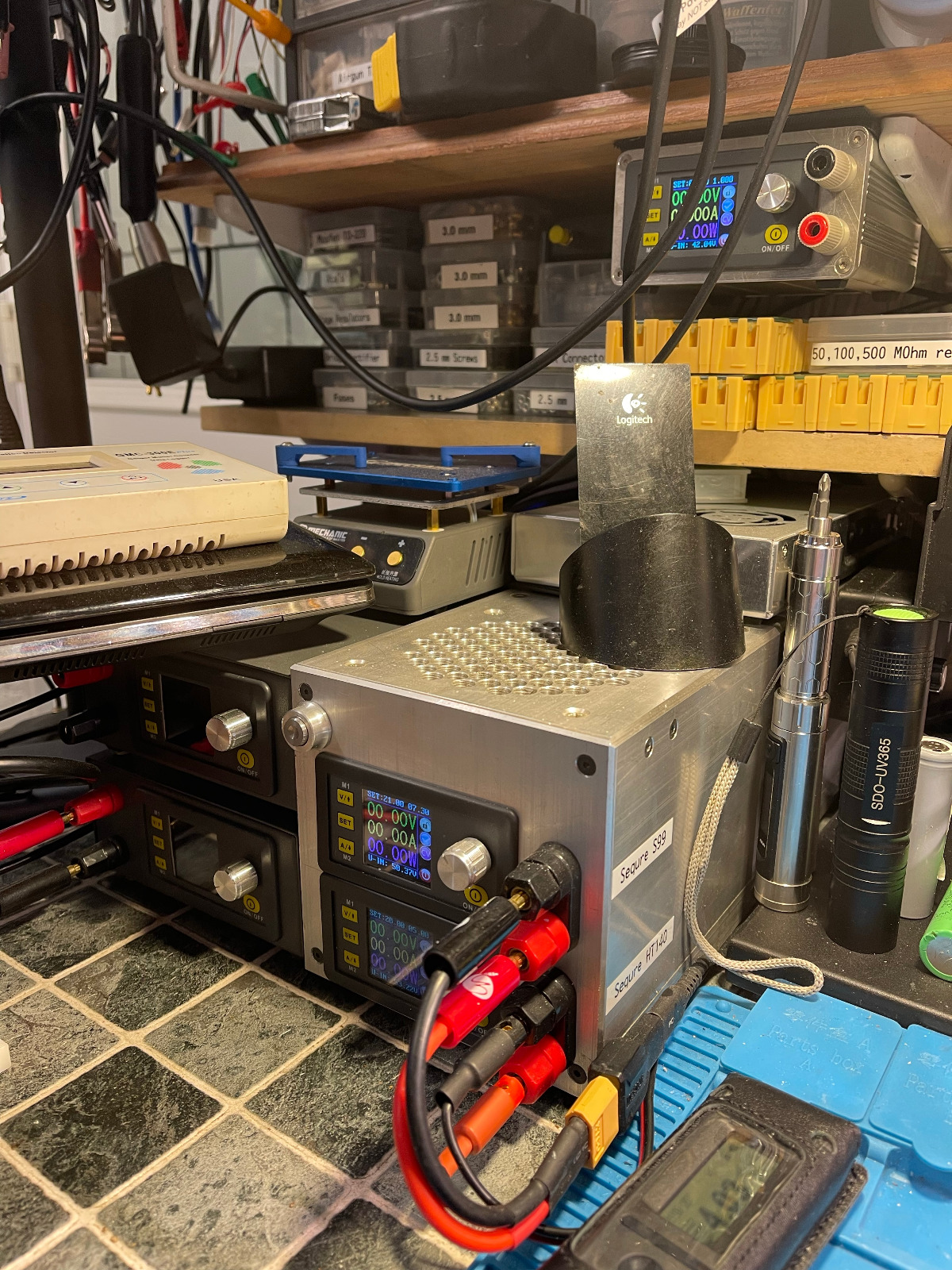- Forum
- Geiger counter discussions
- Commericial geiger counters
- A little gem - The Yaorea YRG01 (Review & Mod)
A little gem - The Yaorea YRG01 (Review & Mod)
- ChrisLX200
-

- Offline
- Elite Member
-

Less
More
- Posts: 161
- Thank you received: 8
7 months 1 week ago #7378
by ChrisLX200
Replied by ChrisLX200 on topic A little gem - The Yaorea YRG01 (Review & Mod)
I can't see any qualitative difference between powering the Cajoes on battery and via the USB hub (had to swap the PSU out as it had died some time ago so now using one from a RaspberryPi). The three Cajoes are similar but more 'spikey' than the RHElectronics MyGeiger V.3 with the SBM-20 tube in it. To be expected given the price difference. The MyGeiger gets its power from a built-in lipo pack, charged via USB connection to laptop. I could check to see how much ripple is on the power line to the Cajoes. Only decent linear supply I have is an old TTi bench PSU.
Please Log in or Create an account to join the conversation.
7 months 1 week ago - 7 months 1 week ago #7380
by Simomax
Replied by Simomax on topic A little gem - The Yaorea YRG01 (Review & Mod)
What I am referring to are the spikes that you can see in the graph below. This is caused by the output filter capacitor basically dying. Traditional linear power supplies simply used AC to transform the voltage down, rectified to DC and then smoothed with the output filter capacitor taking the 50Hz lumps and bumps out of the DC output. Low frequency and could be large values, so gives a super nice smooth output. Modern SMPS use high frequency DC pulses into a small transformer, then the DC pulses are run through half wave rectification (only half is needed as this is pulsed DC) and then smoothed with a much smaller (than a linear PSU) capacitor that is tuned to the frequency of the switching pulses. As the frequency is high (a few KHz) these capacitors get hot, then eventually dry out, reduce capacitance and cause the DC pulses to make their way through to whatever it is powering. Add more current to the mix, the capacitor gets hotter, lasts less and when the DC pulses make their way through they are often more powerful than if a small current is pulled. Generally, they are pretty crappy for running sensitive equipment, unless you spend a lot of money on one. I have some good SMPS's. One is just like any normal inline power supply. It's 18v at about an amp. It is medical grade and cost me about £70 IIRC. Another is a Traco 5v 3a metal cage internal chassis type power supply. That came in a weather station display I bought for modification. Again that is an expensive SMPS, maybe around £50-60. Both of these offer excellent filtering and isolation from mains, hence their price. A cheap £6.99 wall wart (most USB chargers for example) use the minimum of components as they are designed to just charge a battery. Using these types on sensitive equipment is a backwards step. And not all SMPS are equal, by a long shot, so best to check the ripple as you want close to 0mV. ~10mV should be acceptable. 30mV, I'd throw it away.
In the graph you see all the little spikelets that are not coming from the geiger tube, but from the power rail, due to a bad PSU. It had been in service for around 8 years, which is really good. It was a reasonable quality PSU too from some HDMI over CAT6 converters I installed some time back and were surplus. Eventually though it's capacitor dried out a bit, wasn't smoothing properly, and those DC pulses made their way into the Geiger counter (not a cheap one either - a NetIO GC10.) If you look at the bottom graph, the long term trend, you can see at the right the counts have elevated from the normal. This was simply due to the power supply dying. So that is why I suggest a good quality PSU, or batteries.
In the graph you see all the little spikelets that are not coming from the geiger tube, but from the power rail, due to a bad PSU. It had been in service for around 8 years, which is really good. It was a reasonable quality PSU too from some HDMI over CAT6 converters I installed some time back and were surplus. Eventually though it's capacitor dried out a bit, wasn't smoothing properly, and those DC pulses made their way into the Geiger counter (not a cheap one either - a NetIO GC10.) If you look at the bottom graph, the long term trend, you can see at the right the counts have elevated from the normal. This was simply due to the power supply dying. So that is why I suggest a good quality PSU, or batteries.
Attachments:
Last edit: 7 months 1 week ago by Simomax.
Please Log in or Create an account to join the conversation.
7 months 1 week ago - 7 months 1 week ago #7384
by Simomax
Replied by Simomax on topic A little gem - The Yaorea YRG01 (Review & Mod)
I have tested the power consumption of this counter in pretty much all configurations. There is a little bit of ambiguity between having a battery fitted and full charged and not having one fitted. I think this is due to some current draw from the battery as well as the 5v input, and why it occasionally tops up the battery. Also enabling clicks appears to add more current draw in certain configurations than others. I did not test any consumption with the disco LEDs on. Here are the results:
During LPM the BLE and ESP are always off. When running on 5v USB with a full battery, it will occasionally draw up to an additional 22mA to top up the battery.
The BLE when enabled adds another 4~5mA across all configurations, and the ESP adds another ~95mA across all configurations.
5v USB input - No battery fitted
LPM ~10mA / ~10mA (with clicks enabled)
RPM ~55mA / ~60mA (with clicks enabled)
5v - full battery
LPM ~4mA / ~4mA (with clicks enabled)
RPM ~60mA / ~78mA (with clicks enabled)
5v - empty battery
LPM ~450mA / ~452mA (with clicks enabled)
RPM ~478mA / ~480mA (with clicks enabled)
Battery Only 4.2v Full
LPM ~6mA / ~9mA (with clicks enabled)
RPM ~57mA / ~77mA (with clicks enabled)
Running on a full (4.2v) battery, with everything enabled it is going to draw ~177mA, so for uploading to radmon.org, or MQTT or something else it would be prudent to run this on a 5v supply permanently. Keeping the battery in place offers a nice ~14 hours of backup runtime. Turning everything off and letting it drop into LPM consumes around 6mA, so should theoretically run for around 18 days on a full charge and whilst won't be uploading to the internet, it will be logging the counts and storing them on the device itself.
LPM = Low Power Mode
RPM = Regular Power Mode
BLE = Bluetooth Low Energy
ESP = ESP8266During LPM the BLE and ESP are always off. When running on 5v USB with a full battery, it will occasionally draw up to an additional 22mA to top up the battery.
The BLE when enabled adds another 4~5mA across all configurations, and the ESP adds another ~95mA across all configurations.
5v USB input - No battery fitted
LPM ~10mA / ~10mA (with clicks enabled)
RPM ~55mA / ~60mA (with clicks enabled)
5v - full battery
LPM ~4mA / ~4mA (with clicks enabled)
RPM ~60mA / ~78mA (with clicks enabled)
5v - empty battery
LPM ~450mA / ~452mA (with clicks enabled)
RPM ~478mA / ~480mA (with clicks enabled)
Battery Only 4.2v Full
LPM ~6mA / ~9mA (with clicks enabled)
RPM ~57mA / ~77mA (with clicks enabled)
Running on a full (4.2v) battery, with everything enabled it is going to draw ~177mA, so for uploading to radmon.org, or MQTT or something else it would be prudent to run this on a 5v supply permanently. Keeping the battery in place offers a nice ~14 hours of backup runtime. Turning everything off and letting it drop into LPM consumes around 6mA, so should theoretically run for around 18 days on a full charge and whilst won't be uploading to the internet, it will be logging the counts and storing them on the device itself.
Last edit: 7 months 1 week ago by Simomax.
Please Log in or Create an account to join the conversation.
- ChrisLX200
-

- Offline
- Elite Member
-

Less
More
- Posts: 161
- Thank you received: 8
7 months 1 week ago #7385
by ChrisLX200
Replied by ChrisLX200 on topic A little gem - The Yaorea YRG01 (Review & Mod)
Interesting info. I'll do the same with the Cajoes later but I think we already know their power consumption is more than twice that with no battery fitted. I recall there is a jumper which disables clicks when removed although I've never tried it.
For powering most devices on my bench I use these little buck converters, I have about a dozen of the things mainly because for a short time they were offered at £5 each on Amazon. Not sure why they were that price but I bought 12 and they rapidly sold out after that. Two are powered by a Meanwell PSU, the other two bottom-right I spent extra money on a fairly expensive mains PSU and filter setup, then made the aluminium case to hold them. The remainder are scattered around the house powered by various wall warts and used for non-critical tasks. Anyway, they offer a good estimate of power consumption and that's how I measured the Cajoes (rather casually, need to revisit).
For powering most devices on my bench I use these little buck converters, I have about a dozen of the things mainly because for a short time they were offered at £5 each on Amazon. Not sure why they were that price but I bought 12 and they rapidly sold out after that. Two are powered by a Meanwell PSU, the other two bottom-right I spent extra money on a fairly expensive mains PSU and filter setup, then made the aluminium case to hold them. The remainder are scattered around the house powered by various wall warts and used for non-critical tasks. Anyway, they offer a good estimate of power consumption and that's how I measured the Cajoes (rather casually, need to revisit).
Please Log in or Create an account to join the conversation.
- ChrisLX200
-

- Offline
- Elite Member
-

Less
More
- Posts: 161
- Thank you received: 8
7 months 1 week ago - 7 months 1 week ago #7392
by ChrisLX200
Replied by ChrisLX200 on topic A little gem - The Yaorea YRG01 (Review & Mod)
My YRG01 turned up today  I was surprised it's also listed on Amazon UK at a not-too-inflated price of £27.16, you can usually add a 50% mark up c.f. Aliexpress prices. Apparently not all examples are UV sensitive and it was suggested it may be due to excessively high tube voltage. I'll play with mine later but it's clear the ESP32 dev boards I have won't fit inside the battery compartment so your ESP8266 mod looks the best option.
I was surprised it's also listed on Amazon UK at a not-too-inflated price of £27.16, you can usually add a 50% mark up c.f. Aliexpress prices. Apparently not all examples are UV sensitive and it was suggested it may be due to excessively high tube voltage. I'll play with mine later but it's clear the ESP32 dev boards I have won't fit inside the battery compartment so your ESP8266 mod looks the best option.
I can confirm my example is also UV sensitive, similar to the 4011 I removed from a GMC GC300E+ which I replaced with an SBM-20
I can confirm my example is also UV sensitive, similar to the 4011 I removed from a GMC GC300E+ which I replaced with an SBM-20
Last edit: 7 months 1 week ago by ChrisLX200.
Please Log in or Create an account to join the conversation.
7 months 1 week ago #7394
by Simomax
Replied by Simomax on topic A little gem - The Yaorea YRG01 (Review & Mod)
The voltage has no bearing on whether a tube is light sensitive or not. The voltage may affect the amount of counts given if a light sensitive tube is affected by light, but doesn't dictate whether a tube is light sensitive or not. This is probably some confusion if people have had counters with differing voltages, or differing tubes, some sensitive, some not. But then I have to ask, how many people with these counters have managed to successfully read the voltage correctly? I'll not say none, but I certainly assume, not all. I bought two, the voltage in both is (probably less than, I'm being quite liberal here) +-2v. One tube is sensitive at 365nm. I haven't tested the other. On Aliexpress the store shows 600+ units in stock for sale and it appears the tubes have a custom model number which suggests they bought big batches of parts and the tubes may have come from one single batch They are knowingly covering their tubes with UV blocking material.
The voltage isn't excessively high, but it is at the top end of the specs. 450v is still within specification, if the max voltage is 450v. This should be the max voltage before the tube starts to reach the right side of the plateau and start to go up, when avalanches might form. Based on my experience with two of these units both operating at 450v, they both operate really well and actually a better example of a glass tube counter. It's horses for corses with this little counter. It isn't designed for outside, nor should it really be used outside, but then it shouldn't be subject to light interference from inside. The UV shielding film looks to do a good job. My 365nm flashlight doesn't affect it indoors. I haven't checked outdoors with the sun. Nor am I going to. I know at first these units were sold without the UV film for two reasons, I have seen this in videos and the designer put LEDs there, behind the tube. They obviously didn't realize this at first, and now they provide the UV film instead.
My guess is they are all light sensitive, and probably always have been. Maybe some early ones weren't, thus the LEDs. All of this would lead to confusion, so I can only go from the latest batch, which I believe both our counters are from - that 600+ stock they have.
Based on all of this, I would only ever assume these counters, at least the tube they use is light sensitive, period. And I'm happy with this tube. I haven't experienced any avalanching, or even what feels close to an avalanche testing these with any of my sources, or UV light, they seem very solid. So, as I know one of mine is light sensitive (I will check the other now) I can only work with them as though they are. It really matters not.
The voltage isn't excessively high, but it is at the top end of the specs. 450v is still within specification, if the max voltage is 450v. This should be the max voltage before the tube starts to reach the right side of the plateau and start to go up, when avalanches might form. Based on my experience with two of these units both operating at 450v, they both operate really well and actually a better example of a glass tube counter. It's horses for corses with this little counter. It isn't designed for outside, nor should it really be used outside, but then it shouldn't be subject to light interference from inside. The UV shielding film looks to do a good job. My 365nm flashlight doesn't affect it indoors. I haven't checked outdoors with the sun. Nor am I going to. I know at first these units were sold without the UV film for two reasons, I have seen this in videos and the designer put LEDs there, behind the tube. They obviously didn't realize this at first, and now they provide the UV film instead.
My guess is they are all light sensitive, and probably always have been. Maybe some early ones weren't, thus the LEDs. All of this would lead to confusion, so I can only go from the latest batch, which I believe both our counters are from - that 600+ stock they have.
Based on all of this, I would only ever assume these counters, at least the tube they use is light sensitive, period. And I'm happy with this tube. I haven't experienced any avalanching, or even what feels close to an avalanche testing these with any of my sources, or UV light, they seem very solid. So, as I know one of mine is light sensitive (I will check the other now) I can only work with them as though they are. It really matters not.
Please Log in or Create an account to join the conversation.
Moderators: Gamma-Man
- Forum
- Geiger counter discussions
- Commericial geiger counters
- A little gem - The Yaorea YRG01 (Review & Mod)
Time to create page: 0.231 seconds




